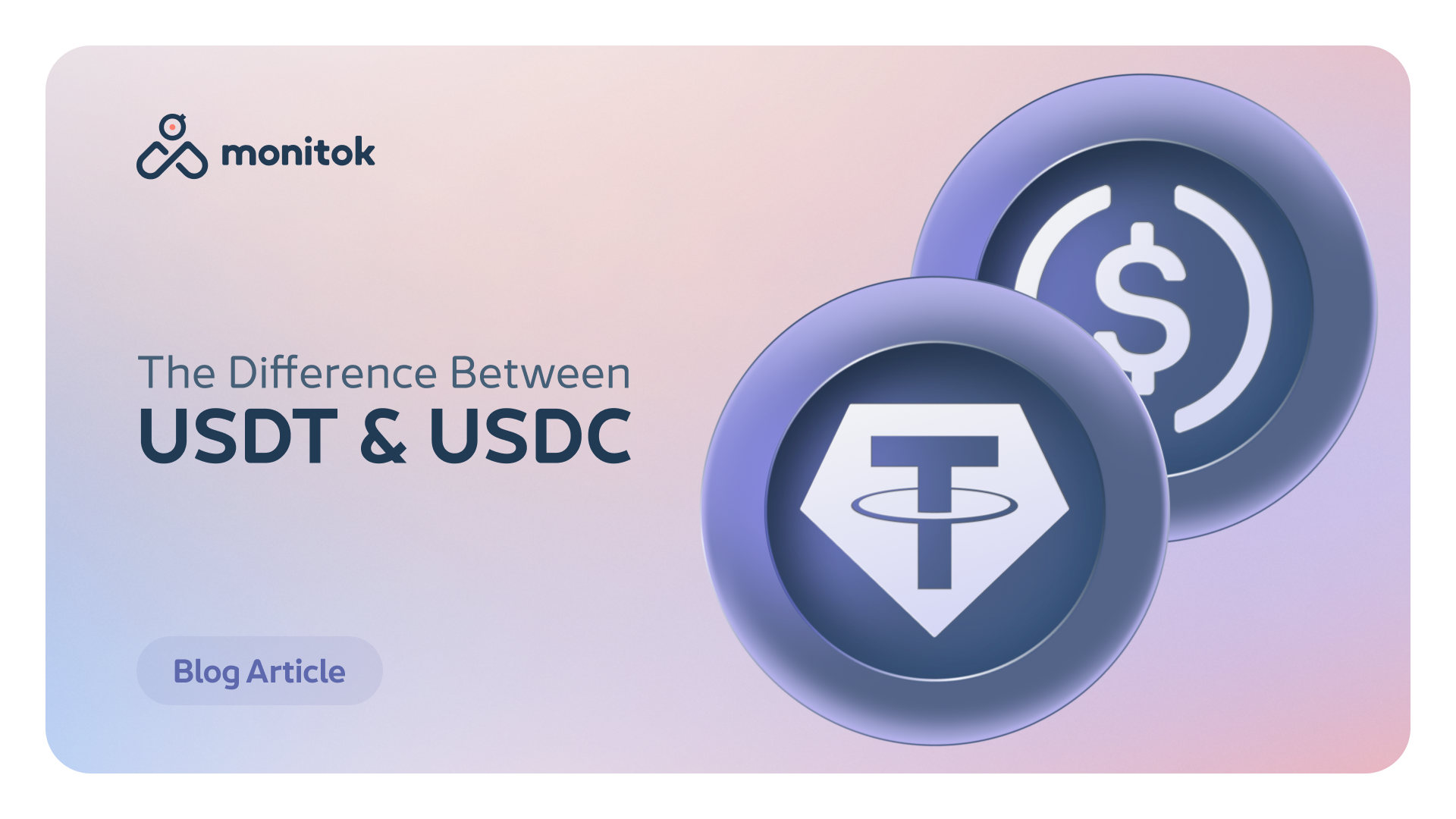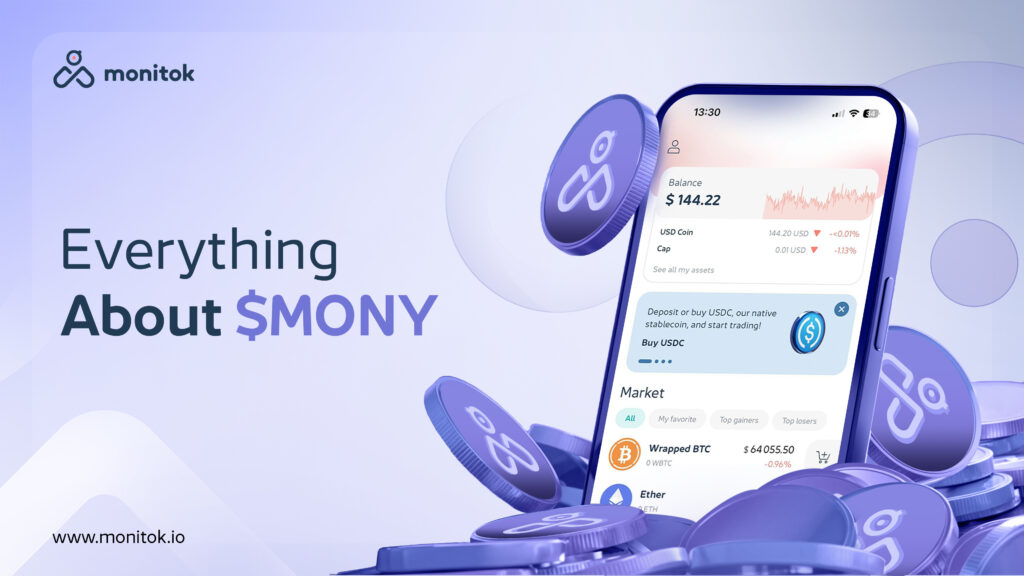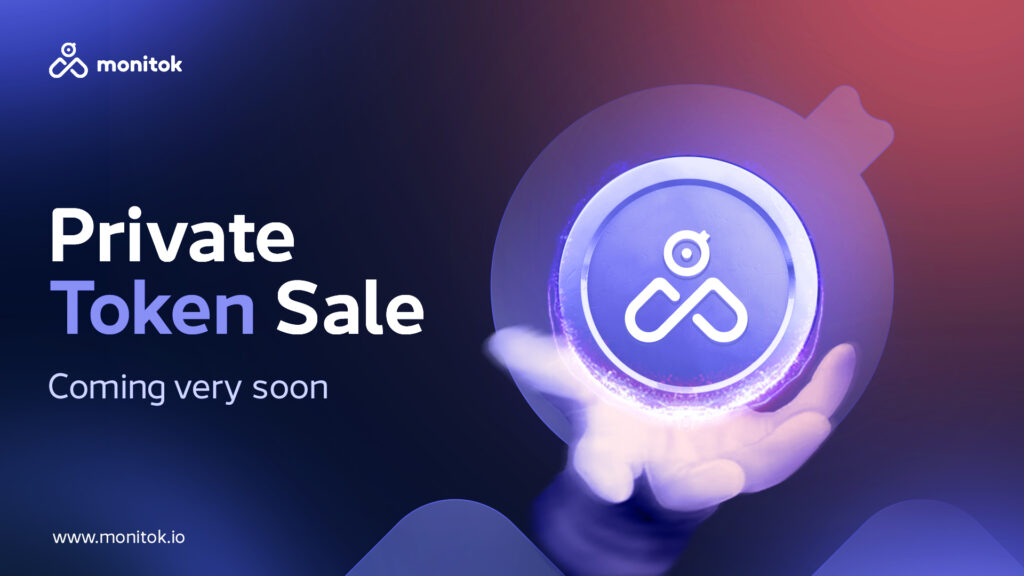Stabiliosios monetos tapo itin svarbia kriptovaliutų turto klase, suteikiančia stabilumo nuo nepastovumo. Tarp svarbiausių stabiliųjų monetų yra JAV dolerių moneta (USDC) ir Tether (USDT). Šiame straipsnyje aiškinami USDC ir USDT skirtumai, nagrinėjamos jų savybės, apimtys, panašumai ir skirtumai.
Kas yra stabilios monetos? Kaip jie veikia?
Stabiliosios monetos - tai kriptovaliutos rūšis, skirta sumažinti kainų svyravimus, nes yra susietos su rezerviniu turtu, paprastai fiat valiuta, pavyzdžiui, JAV doleriu. Jie suteikia privalumų, pvz. kriptovaliutos, pavyzdžiui, greiti sandoriai ir maži mokesčiai, išlaikant stabilią vertę. Stablecoins savo stabilumą pasiekia įvairiais mechanizmais, įskaitant įkeitimą fiat ar kitu turtu arba algoritminius koregavimus.
Stabiliųjų monetų tipai
- Fiat įkaitu užtikrintos stabiliosios monetos: Jos yra padengtos fiat valiutos atsargomis, laikomomis banko sąskaitoje arba lygiavertėje sąskaitoje. Kiekvienas išleistas stablecoinas atitinka tam tikrą fiat valiutos kiekį.
- Kriptografiniu įkaitu užtikrintos stabiliosios monetos: Juose kaip įkaitas naudojamos kriptovaliutos, kurios dažnai būna perteklinės, kad būtų atsižvelgta į pagrindinio turto kintamumą.
- Algoritminės stabilios monetos: Jos remiasi algoritmais ir išmaniosiomis sutartimis, kad išlaikytų savo pegasą, reguliuodamos pasiūlą pagal rinkos paklausą.
Kas yra USDC?
USD Coin (USDC) - tai visiškai įkaitu užtikrintas JAV doleriais paremtas stablecoin, kurį pradėjo platinti Centro konsorciumas, įkurtas Apskritimas ir Coinbase. Kiekvienas USDC žetonas yra padengtas vienu doleriu, laikomu rezerve, užtikrinant 1:1 vertę su JAV doleriu.
Pagrindinės USDC funkcijos
- Skaidrumas: USDC reguliariai atlieka auditą ir teikia ataskaitas apie atsargas, taip užtikrindama skaidrumą ir pasitikėjimą. Centro konsorciumas kas mėnesį teikia stambios apskaitos įmonės parengtas atestavimo ataskaitas, kuriomis tikrinami USDC rezervai.
- Reglamentas: USDC išleidžia reguliuojamos finansų įstaigos, todėl USDC atitinka finansinius reglamentus ir standartus. Joje laikomasi griežtų "Pažink savo klientą" (KYC) ir kovos su pinigų plovimu (AML) procedūrų.
- Saugumas: Sukurta "Ethereum" blokų grandinės pagrindu, USDC pasižymi dideliu saugumu ir išmaniųjų sutarčių funkcionalumu. Ji taip pat prieinama kitose blokų grandinės platformose, pvz. Arbitrum, "Algorand", "Solana" ir "Stellar", taip padidinant jos sąveikumą.
- Naudojimo atvejai: USDC plačiai naudojamas "DeFi" programose, prekyboje, mokėjimuose ir pinigų pervedimuose. Dėl savo stabilumo ir skaidrumo jis yra priimtiniausias pasirinkimas įvairioms finansinėms operacijoms.
USDC apimtis
USDC apimtis ir rinkos kapitalizacija smarkiai išaugo dėl to, kad ji buvo naudojama prekybos, mokėjimų ir decentralizuotų finansų (DeFi) programose. Dėl savo skaidrumo ir atitikties teisės aktų reikalavimams ji tapo prioritetiniu tiek institucijų, tiek individualių naudotojų pasirinkimu. Nuo 2024 m, USDC rinkos kapitalizacija sudaro daugiau nei $32 mlrd. eurų, o tai rodo, kad kriptovaliutų bendruomenė plačiai ją priėmė ir ja pasitiki.
Kas yra USDT?
Tether (USDT) yra dar viena pirmaujanti stabilioji valiuta, susieta su JAV doleriu. Jį pradėjo platinti "Tether Limited", USDT siekia suderinti kriptovaliutų sandorių privalumus su JAV dolerio stabilumu.
Pagrindinės USDT savybės
- Likvidumas: USDT pasižymi dideliu likvidumu ir yra plačiai naudojamas kriptovaliutų biržose. Pagal prekybos apimtis ji dažnai yra labiausiai prekiaujama kriptovaliuta, o pagal dienos prekybos apimtis lenkia net bitkoiną.
- Priėmimas: Tai viena iš seniausių ir plačiausiai paplitusių stabiliųjų monetų, turinti stiprią vietą prekybos bendruomenėje. USDT galima naudoti daugelyje blokų grandinių, įskaitant "Ethereum", "Arbitrum", "Tron", "EOS" ir kitas, taip padidinant jos pasiekiamumą ir naudingumą.
- Universalumas: USDT prieinamumas keliose blokų grandinės platformose didina jos universalumą ir pritaikomumą įvairiose srityse - nuo prekybos iki perlaidų.
- Naudojimo atvejai: USDT plačiai naudojama prekyboje, nes prekiautojai gali greitai perkelti lėšas iš vienos biržos į kitą, apsidrausti nuo rinkos svyravimų ir pasinaudoti arbitražo galimybėmis.
USDT apimtis
USDT nuolat užima vieną iš aukščiausių pozicijų pagal prekybos apimtį ir rinkos kapitalizaciją. Jo platus pritaikymas ir integracija su daugeliu biržų ir platformų prisideda prie didelio jo dalyvavimo rinkoje. USDT rinkos kapitalizacija viršija $111 mlrd., todėl pagal rinkos vertę ir prekybos apimtį tai yra didžiausia stabilioji valiuta.
USDC vs USDT
Surinkome USDC ir USDT panašumai ir skirtumai ir pateikė juos toliau.
| Kategorija | USDC | USDT |
|---|---|---|
| Kūrėjas | Centro konsorciumas (pagal ratą) | "Tether Limited |
| Įsteigimo metai | 2018 | 2014 |
| Kainos fiksatorius | 1 USDC : 1 USD | 1 USDT : 1 USD |
| Rinkos kapitalizacija (24 m. gegužės mėn.) | $32,4 mlrd. | $111,9 mlrd. |
| Palaikymas | 100% pinigai ir pinigų ekvivalentai | 1:1 likvidžiu skolos turtu, iždo vertybiniais popieriais ir grynaisiais pinigais |
| Audito dažnumas | Mėnesinis | Nereguliarus |
| Kainos rizika / Rizika prarasti 1:1 susiejimą | Nulis, nes jis 100% gali būti išperkamas dėl visada skysto pagrindo. | Kainos rizika nenulinė, tačiau paprastai ji išlieka labai artima $1, nes ją galima išpirkti (nors trumpuoju laikotarpiu ji apsiriboja likvidžiu turtu). Palyginimui, per UST/LUNA krachą USDT išliko per kelis % nuo $1, o kalbama, kad sėkmingai išperkama $1b+. |
| Teisinis statusas | Tokio tipo stabilios monetos (100% išperkamos) yra tai, ką dabartiniai reglamentų projektai (ypač JAV) siekia licencijuoti kaip pirmą žingsnį. Daugelyje jurisdikcijų, pavyzdžiui, Jungtinėje Karalystėje, jie laikomi elektroniniais pinigais. | Neaišku, |
| Apskaita | Patikimas turtas dėl nulinės kainos rizikos, reguliavimo statuso ir skaidrių audito ataskaitų. | Nepatikima dėl kainos rizikos, neskaidrios paramos ir neaiškaus reguliavimo statuso. |
Šaltinis: mokėjimų asociacija
Pagrindiniai USDC ir USDT panašumai
- Susietas su JAV doleriu: Tiek USDC, tiek USDT yra susieti su JAV doleriu, taip užtikrinant stabilumą.
- Naudojimo atvejai: Jie naudojami prekybai, mokėjimams, pervedimams ir kaip užstatas DeFi programose.
- Blokų grandinės integracija: Abi šios priemonės yra prieinamos keliose blokų grandinės platformose, todėl užtikrinamas platus pritaikomumas.
- Likvidumas: Abi stabiliosios monetos pasižymi dideliu likvidumu, todėl yra patrauklios prekiautojams ir investuotojams.
Pagrindiniai skirtumai tarp USDC ir USDT
- Skaidrumas: USDC garsėja didesniu skaidrumu, reguliariai atliekamu auditu ir išsamiomis atsargų ataskaitomis. USDT susidūrė su kruopščiu tikrinimu dėl savo atsargų praktikos ir skaidrumo. Tether buvo įsitraukusi į teisinius ginčus ir reguliavimo iššūkius dėl savo teiginių apie visišką padengimą rezervais.
- Reglamentas: USDC griežtai laikosi reguliavimo standartų, o jas išduoda reguliuojamos finansų įstaigos. USDT veikia neskaidresnėje reguliavimo aplinkoje. Nors "Tether" ėmėsi priemonių skaidrumui didinti, ji vis dar nesuteikia tokio paties lygio garantijų kaip USDC.
- Priėmimas: USDT yra plačiau paplitusi ir likvidesnė, todėl ji labiau paplitusi prekybos veikloje. USDC, nors taip pat plačiai paplitusi, yra ypač mėgstama dėl atitikties teisės aktų reikalavimams ir skaidrumo.
- Rezervų valdymas: USDC atsargos laikomos grynaisiais pinigais ir trumpalaikėmis JAV iždo obligacijomis, užtikrinančiomis aukštą saugumo ir likvidumo lygį. USDT atsargas sudaro grynųjų pinigų, komercinių vekselių ir kito turto derinys, todėl kilo klausimų dėl jo likvidumo ir rizikos.
USDT ir USDC: iššūkiai
Tiek USDT, tiek USDC susiduria su reguliavimo kontrole ir iššūkiais, susijusiais su jų susiejimo išlaikymu rinkos svyravimų metu. Skaidrumas ir reguliavimo reikalavimų laikymasis tebėra itin svarbūs klausimai, ypač USDT. Abiem stabiliesiems pinigams svarbiausia užtikrinti pasitikėjimą ir jų vertės stabilumą. Be to, iššūkių kelia besikeičianti stabiliųjų monetų reguliavimo aplinka, nes vyriausybės ir reguliavimo institucijos vis daugiau dėmesio skiria šio turto stabilumui ir saugumui užtikrinti.
Ar turėčiau investuoti į USDC, ar į USDT?
Sprendimas tarp USDC ir USDT priklauso nuo jūsų prioritetų:
- Skaidrumas ir reguliavimas: Jei jums labiausiai rūpi skaidrumas ir atitiktis teisės aktų reikalavimams, USDC gali būti geresnis pasirinkimas. Reguliarus auditas ir reguliavimo standartų laikymasis užtikrina ramybę.
- Likvidumas ir priėmimas: Jei pirmenybę teikiate likvidumui ir plačiam pripažinimui, USDT gali būti tinkamesnis. Jo dominuojančios prekybos apimtys ir buvimas keliose biržose suteikia daugiau lankstumo prekiautojams.
- Naudojimo atvejis: Apsvarstykite savo pagrindinį naudojimo atvejį. Ilgalaikiam laikymui arba naudojimui reguliuojamose finansinėse operacijose gali būti naudingas USDC skaidrumas. Aktyviai prekybai naudingas USDT likvidumas.
Kad ir į kurį stablecoin nuspręstumėte investuoti, viską galite atlikti "Monitok" piniginėje.
-> kaip pirkti USDC per kelias sekundes
-> Kaip nusipirkti USDT per kelias sekundes
Suprasdami USDC ir USDT niuansus, galite priimti pagrįstus sprendimus, atsižvelgdami į skaidrumo, atitikties teisės aktams ir likvidumo poreikius. Abi stabiliosios monetos atlieka svarbų vaidmenį kriptovaliutų ekosistemoje, užtikrindamos stabilumą ir naudingumą nepastovioje rinkoje.
DUK
Ar USDC ir USDT yra tas pats?
Ne, nors abi šios valiutos yra stabilios monetos, susietos su JAV doleriu, jos skiriasi savo skaidrumu, atitiktimi teisės aktams ir pripažinimu rinkoje. USDC yra žinomas dėl savo skaidrumo ir reguliavimo laikymosi, o USDT susidūrė su kontrole dėl savo rezervų praktikos.
USDT vs USDC: Kuris stablecoin yra saugesnis?
USDC apskritai laikomas saugesniu dėl skaidrumo ir reguliavimo laikymosi, o USDT susidūrė su klausimais dėl savo atsargų praktikos. Tačiau dėl didelio USDT likvidumo ji yra praktiškas prekiautojų pasirinkimas.
Ar galiu pervesti USDT į USDC?
Taip, USDT galite konvertuoti į USDC įvairiose kriptovaliutų biržose, kurios palaiko abi stabilias monetas, pavyzdžiui, Monitok. Šis procesas paprastai apima USDT keitimą į USDC, dažnai su minimaliais mokesčiais ir greitu vykdymu.
Ar galiu naudoti stablecoins kasdienėms operacijoms?
Taip, stabiliosios monetos gali būti naudojamos kasdienėms operacijoms, pervedimams ir mokėjimams, nes, palyginti su nepastoviomis kriptovaliutomis, turi stabilią vertę. Daugelis platformų ir paslaugų dabar priima stablecoins įvairioms operacijoms atlikti.
Ar yra tokių stabiliųjų monetų, kaip USDC ir USDT, taisyklių?
Stabiliosioms monetoms taikomas įvairaus laipsnio reguliavimas, priklausomai nuo jurisdikcijos. USDC laikosi griežtesnių reguliavimo standartų, o USDT veikia mažiau reguliuojamoje aplinkoje. Reguliavimo priežiūra didėja, o valdžios institucijos daugiausia dėmesio skiria šio turto stabilumui ir saugumui užtikrinti.



